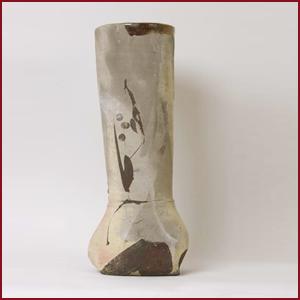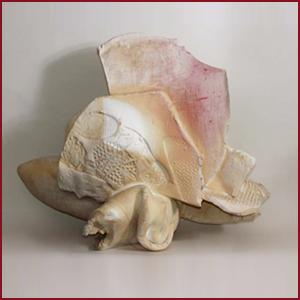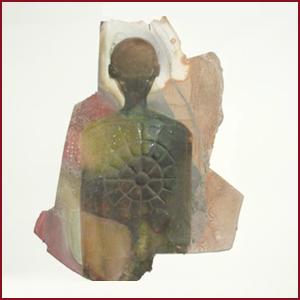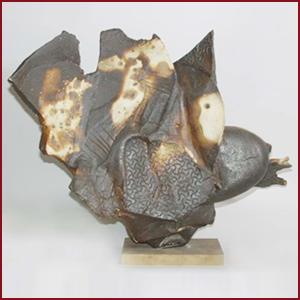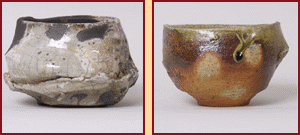
September 11–December 11, 2004
Inaugural exhibition
Some say that it takes seven years of practice to gain mastery of the potter’s wheel, to acquire enough skill to be able to create the shape envisioned in one’s mind’s eye. Having reached this level of expertise, many potters become champions of production, making matching mugs, dinnerware series, or tea sets. Others are more interested in the decorative aspects of ceramics: gracefully rounded vases, long-necked bottles, or smoothly contoured plates. Beyond the shapes, there are glazing and decorating skills to be acquired and firing techniques to be learned. Pottery, as such, was bound by tradition, defined by utilization, and limited to vessel format. Then, during the 1950s, the established ceramic aesthetic was challenged–just as painting was challenged by the Abstract Expressionist Movement, ceramic objects graduated from function to concept.
Inferno: The Ceramic Art of Paul Soldner will pay tribute to Soldner’s great contribution to a historic era in ceramics that has been termed the “Clay Revolution” or “West Coast Ceramics.” Soldner, who had no aspirations to become a ceramic artist, started out making conventional pieces. This exhibition will cover the entire scope of Soldner’s ceramic career, from his early straightforward pieces to experimental floor pots of enormous size and scale, from fat-necked bottles to figure-stamped surfaces. There will be examples of Soldner’s calligraphic brush work, innovative textures, and sculptural forms. All manners of firing will be represented: raku, low- and high-fire salt, and wood fired work, each signifying years of experimentation and refinement.
The decision to study with Peter Voulkos was a most fortuitous opportunity. Only recently appointed professor of ceramics at the Art Institute, Paul Soldner was Voulkos’s first student. Together, they built the ceramic facility; wheels and kilns were invented as they were built. Soldner led the way with his ingenuity and great mechanical sense, and this experience became the precursor to a later, successful business venture: Soldner Pottery Equipment. Soon joined by a handful of other students (Billy Al Bengston, Michael Frimkess, John Mason, Mac McClain, Ken Price, Janice Roosevelt, Jerry Rothman, and Henry Takemoto), Voulkos led this group into unmarked territory–a ground-breaking period of ceramic making, where the freedom to create and experiment had no limitations.
During World War II, Paul Soldner’s pre-med course was interrupted with a call to serve in the Army as a medic, an experience that altered his ambitions of becoming a doctor. After the war, Soldner attained a bachelor’s degree in art at Bluffton College, Illinois and a master’s degree from the University of Colorado in Boulder. While in Colorado, Soldner was introduced to Katie Horseman, a visiting ceramics instructor from Edinburgh College of Art in Scotland. This meeting proved to be the impetus for his decision to become a potter and to study with Peter Voulkos at the Los Angeles County Art Institute, now known as Otis College of Art and Design.
In 1956, after completing his MFA in ceramics, Paul Soldner had every intention of setting up his family and studio on property he had purchased in Aspen, Colorado; however, an opportunity to substitute teach in the ceramics department at Scripps College arose. Paul accepted the position, and one year led to another and another. Soldner spent 37 years at Scripps, with an arrangement that allowed him to teach half the year at Scripps and spend the other half in Colorado. During his thirty-seven-year tenure at Scripps, Paul influenced a huge number of students who went on to develop clay careers of their own. His Zen-like philosophy spilled into his classroom where, following his example, students felt free to explore. He introduced unorthodox methods of firing and post-firing, pushed the limits of form and surface design, and, above all, adopted an attitude of acceptance when unexpected results ensued.
The word Inferno, as used in the title of our inaugural exhibition, has an obvious connection with the firing process used to vitrify the clay and make glazes permanent. Inferno also refers to Soldner himself. It brings to mind the spirit and physical vigor of a risk taker, an influential artist who still, at 83 years of age, welcomes the unknown and challenges the norm.
Soldner’s works have been exhibited in all of the major cities of Europe and the United States, Canada, Latvia, Japan, Taiwan, Korea, and Australia. He is the author of numerous articles and a book, Kilns and Their Construction. Soldner is the founder and original Chairman of the Board of the Anderson Ranch Arts Center in Snowmass Village, Colorado, known for its excellent summer arts program.
